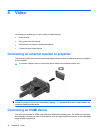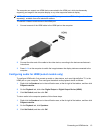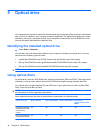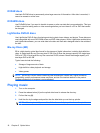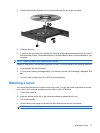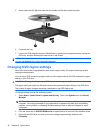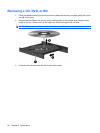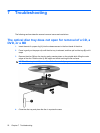
DVD±R discs
Use blank DVD±R discs to permanently store large amounts of information. After data is recorded, it
cannot be erased or written over.
DVD±RW discs
Use DVD±RW discs if you want to be able to erase or write over data that you saved earlier. This type
of disc is ideal for testing audio or video recordings before you burn them to a CD or DVD that cannot
be changed.
LightScribe DVD+R discs
Use LightScribe DVD+R discs for sharing and storing data, home videos, and photos. These discs are
read-compatible with most DVD-ROM drives and DVD video players. With a LightScribe-enabled drive
and LightScribe software, you can write data to the disc and then add a designer label to the outside of
the disc.
Blu-ray Discs (BD)
BD is a high-density optical disc format for the storage of digital information, including high-definition
video. A single-layer Blu-ray Disc can store 25 GB, over 5 times the storage capacity of a single-layer
DVD at 4.7 GB. A dual-layer Blu-ray Disc can store 50 GB, almost 6 times the storage capacity of a
dual-layer DVD at 8.5 GB.
Typical uses include the following:
●
Storage of large amounts of data
●
High-definition video playback and storage
●
Video games
NOTE: As Blu-ray is a new format containing new technologies, certain disc, digital connection,
compatibility, and/or performance issues may arise, and do not constitute defects in the product.
Flawless playback on all systems is not guaranteed.
Playing music
1. Turn on the computer.
2. Press the release button (1) on the optical drive bezel to release the disc tray.
3. Pull out the tray (2).
4. Hold the disc by the edges and position the disc label-side up over the tray spindle.
NOTE: If the tray is not fully accessible, tilt the disc carefully to position it over the spindle.
16 Chapter 5 Optical drive







